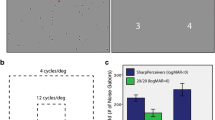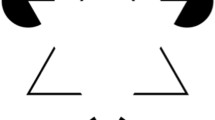Abstract
Interpretations of the mechanisms of perception of contours or of Mach bands have stressed either the role of various spatial derivatives of light intensity at the retina or the importance of various forms of inhibitory effects between neighboring retinal elements. Evidence is presented here in support of the latter type of interpretation. It is considered that the brightness contrast and perceived contours arise from neural elements, each of which is stimulated in proportion to the intensity of photo-receptor excitation at a point of the retina and inhibited in proportion to the mean intensity in some neighborhood of that point. The role of the spatial derivatives is best seen as a particular manifestation of the inhibitory mechanism. Predictions based upon this hypothesis appear to be consistent with experimentally observed evidence.
Similar content being viewed by others
Literature
Burnham, R. W. and J. E. Jackson. 1955. “Mach Rings Verified by Numerical Differentiation.”Science,122, 951–3.
Fry, G. A. 1948. “Mechanisms Subserving Simultaneous Brightness Contrast.”Am. J. of Optom. and Arch. Amer. Acad. Optom.,25, 162–78.
Koffka, K. and M. R. Harrower. 1931. “Colour and Organization.”Psychologische Forschung,15, 145–275.
Ludvigh, E. 1953a. “Perception of Contour. I. Introduction.” U.S. Naval School of Aviation Medicine, Naval Air Station, Pensacola, Fla. Project No. NM 001 075.01.04 (Joint Report No. 4).
Ludvigh, E. 1953b. “Perception of Contour. II. Effect of Change of Retinal Intensity Gradient.” U.S. Naval School of Aviation Medicine, Naval Air Station, Pensacola, Fla. Project No. NM 001 075.01.05 (Joint Report No. 5).
Marshall, W. H. and S. A. Talbot. 1942. “Recent Evidence for Neural Mechanisms in Vision Leading to a General Theory of Sensory Acuity.” Pp. 117–64 inVisual Mechanisms. (H. Klüver, Ed.) Lancaster, Pennsylvania: Jaques Cattell Press.
Author information
Authors and Affiliations
Additional information
This research was supported by the United States Air Force through the Air Force Office of Scientific Research of the Air Research and Development Command under Contract No. AF 18(600)-1454. Reproduction in while or in part is permitted for any purpose of the United States Government.
Rights and permissions
About this article
Cite this article
Greene, P.H. Factors in visual acuity: I. Neural inhibition and the visual perception of contours. Bulletin of Mathematical Biophysics 19, 147–156 (1957). https://doi.org/10.1007/BF02477884
Received:
Issue Date:
DOI: https://doi.org/10.1007/BF02477884




